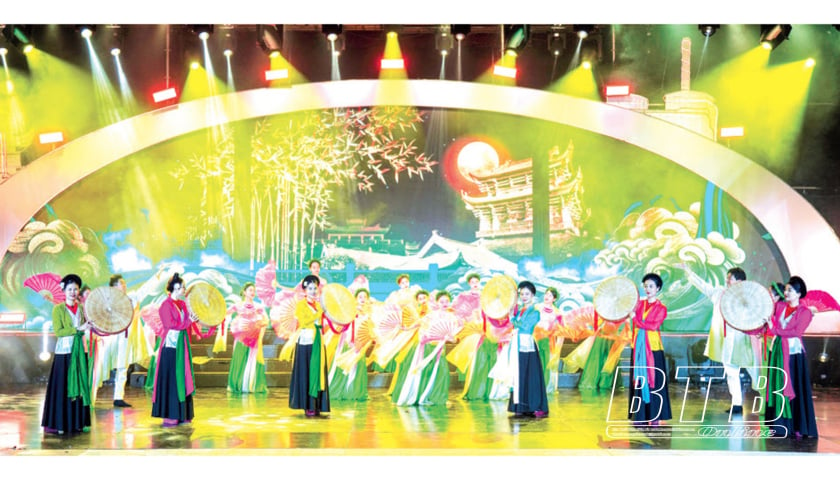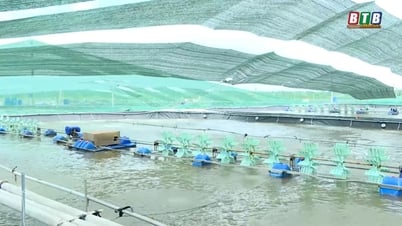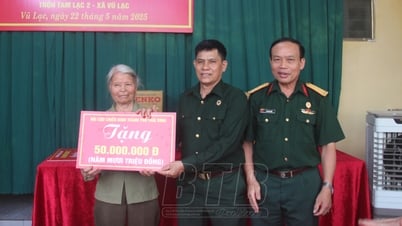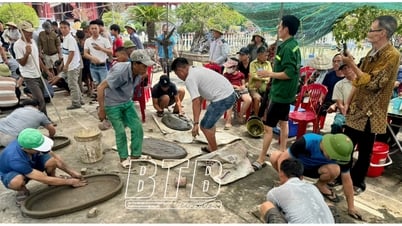Thai Binh Cheo art is recognized as a national intangible cultural heritage from 2023.
In ancient times, people in the Northern Delta region, in addition to rowing boats to fish on rivers and seas, also rowed boats to transport goods or passengers on rivers between regions. The proverb "first near the market, second near the river" was born from that historical environment. The rowing boat fishing songs of coastal fishermen in Thai Binh have existed for a long time, formed on the basis of singing and pushing. The singing leader is the one who catches the lead, the one who initiates the first singing to start the game. The person who catches the lead plays a pivotal role from the beginning to the end of the singing. Therefore, the singing leader must have a good singing voice, be creative, and improvise promptly to create an exciting atmosphere, attract the collective to respond, called "pushing". There are two ways of singing: single singing and double singing.
Single singing is a singing style in which the chanter uses two separate sounds from a sentence or a song so that each double beat matches the rhythm of the chant "Do ta nay". Right from the beginning of the chant, the rowers are ready to wait until the leader finishes saying "Do ta nay", then everyone simultaneously emphasizes the "Do" sound to row and push to match the rhythm and unify the movements. Near the destination, the rhythm of the chant gradually slows down and stops at the boat's mooring point. For example, the verse: "Want to eat goby fish/Run home and tell your mother to build a boat and go" has been cut into the rhythm: "Want to eat/ Goby fish/ Goby fish/ Goby fish/ Goby fish/ Goby fish/ Goby fish/ Goby fish/ Goby fish/ Goby fish/ Goby fish! Run home/ Goby fish/ Goby fish! Tell your mother/ Goby fish/ Goby fish! ... Goby fish/ Goby fish/ Goby fish! Goby fish/ Go
Double chanting is similar to the rhythm of single chanting, but the basic difference is that when the chanter stops after three sounds of “Do ta nay”, the group “xô” with four sounds of “Do ta, do ta”. Although there are many chants that, due to semantic connections, can increase the number of words to three or four, but still ensure the correct rhythm. Thus, if not counting the light “nay” accompaniment sound in the single chanting “Do ta nay”, the double chanting has twice the number of sounds emitted as the single chanting. Double chanting is longer in style, often used when pulling a boat that is slightly stranded on a muddy beach or when a sailboat is sailing steadily on a long journey. For example, the sentence: "When the water rises, the mullet fish eats up/ When the water falls, the mullet fish lies at the mouth of the bank/ Pity the fish that is out of the water and has to dry up/ Pity the brother who has waited in vain" is expressed in the form: "When the water rises, let's go/ let's go! Let's go! Mullet fish/ let's go/ let's go! Let's go! Eat up/ let's go/ let's go! Let's go!..." .
Different from rowing boat songs, ferry songs are the sentences and songs of fishermen or rowers for merchant and transport boats in the river area. Ferry songs are rich in lyricism, have melodious sounds, and echo throughout all rivers. In the past, young men and women on the river banks often sang in the quiet late nights, when boats drifted up and down the river. The way to sing ferry songs is simple and natural. The rower sticks the pole to the bottom of the river, holds the end of the pole with both hands, and leans forward on the shoulder blades, then uses the strength to push the pole in the opposite direction towards the bow of the boat, pushing the boat forward. When pulling up the pole, they turn around and walk leisurely back to the old position, that is, the end of a pole, resting and singing. The rhythm of the rest and the rhythm of the song also depend on the rower, whether the boat is going downstream or upstream, with the wind or against the wind... There are cases where the boat is going late at night, they sit on the side of the boat and sing to each other. There are two ways to sing "do dua": singing in the middle and singing on the road.
The song "Do dua bo dang" usually begins the song with a very long, flexible "o..." sound. The "o" sound at the beginning and middle of the song expresses a melancholy lyricism. The singer is singing and then stops singing halfway, creating a sense of waiting. The boat has gone a distance on the river, the song echoes passionately again. The song "Do dua bo dang" usually takes place when the wind is favorable, the work of rowing is more leisurely, the boat goes downstream gently on the river. For example, a song: Female: "Late at night, the water is calm, the wind is calm/Which pole doesn't you pull out to go to the boat and play". Male: "This boat misses the sea so much/Hung by the mandarin's palace, which way to go?" Female: "Who forbids or fences that river/If you want to go downstream, pay the tax and go downstream"...
The song "Do ferry" is often sung when the boats are crowded and happy to go on a trip on the river, boys and girls sing and respond to each other to express their love. Because it must follow the rules of poetic melody, each person can sing differently. The melody changes more or less depending on the psychological conditions and specific circumstances, so the melody is more varied. For example: "The wild chicken, you are beautiful and show off your feathers/Why don't you let it fight in a cage/Teacher and mother, I have come of age/When I am fifteen or eighteen, I will get married/I am on the street, some have children, some do not/I am ashamed of my friends, I am heartbroken by my parents/Who do I choose to give gifts to my grandmother/Who do I choose to make up for my parents' trust"...
If the ferry singing usually takes place on riverbanks, the dum singing is a form of folk singing that is more popular in many villages. Dum singing exists in two forms: petty singing and wedding singing. The Vi Noi singing melody is the most basic melody of dum singing, but in dum singing in Thai Binh, there is also ferry singing, drum singing, desert singing...
Singing is a free form of singing that does not follow any order of content. While working in the field, the plowman stopped and sang: “Ho...oh...ho/ Hey girl carrying a pair of (but) bright (oh) clouds/If you lack a carrying pole, come here (chù) I will carve it for you/Hey girl wearing a conical hat (but) three (ơ) tam/Is it fate or did you pick up the wrong fate (ơ...ho)...” and the planter in the nearby field responded: “Ho...oh...ho/That guy is plowing the field (ơ) deep/The furrows are straight, the buffalo is tame (ơ...ho)/The farmers and the buffaloes already know each other (ơ)/How can the one standing and the one sitting (walk) turn away (ơ...ho)”.
Funeral singing is a form of collective singing that often appears during festivals, funerals, and holidays. Boys and girls in the village or boys and girls from other villages come together to sing and interact with each other. Funeral singing is often divided into three stages: greeting singing, confession singing, and farewell singing.
Greeting songs, challenging songs, and riddle songs are short verses that start the song, introduce yourself to your friends or suggest that you sing. At this stage, the song has an enthusiastic and joyful atmosphere. For example, the song: "A flock of white storks there/Can you hear me singing these words/Singing the beautiful words of green rice and pink rice/Singing the words of husband and wife, storks"...
The song of confession, love exchange, and wishes is the longest part of the song. It contains a lot of content and is expressed in a gentle lyrical language. The love of the young men and women is expressed through metaphors and comparisons. For example: "Meeting here, let me ask this question/Is the rainwater in the jar still full or empty/So long without raindrops falling/So long without the sound of greeting each other/When will the wind bring the scent of areca nut/So that I can pick the leaves of the rich tree I am weaving"...
Farewell songs are the ending lines of the singing group. They are a few short lines to say goodbye to each other, to make an impression so that each person will remember their promise more. There are lines and songs in the farewell songs, like golden oaths. For example: "Now the night has passed/The farewell is not over, we are not alone/You go back to your homeland and leave it here/I hug this shirt, my dear"...
Lullabies are a type of folk narrative song rich in lyricism, popular in most regions of the country. Lullabies in Thai Binh have the characteristics of the lullaby style of the Northern Delta, showing a relatively uniform rhythm and melody and the way of breathing in the voice, but the musical style and specific content of each song still have their own features. In the northern region of Thai Binh, the opening lullaby often begins with a type of sound with the same tone and different accent, missing the initial consonant and near the end of the rhythm, the syllable suddenly changes rhyme, before leading into the main content of the song. For example: "A a a a...oi/The stork dives into the pond/Eat sour figs (o...o...) eat sour peaches and peaches". In the South, the Southeast woke up and used a song with a series of homophonic sounds with different tones such as: "Bong bong bong bang bang bang", "Ru hoi ru oi ru hoi", "Ha ha ha ha hoi"... For example: "Ha ha ha ha ha hoi.../My child is sleepy and sad/Sad to eat sticky rice, millet porridge and chicken/The house still has one eggplant/How can we have enough rice and feed the child/My child cries and cries/Crying for the first crooked star fruit of the season/The child craves the offerings from the temple/The village's royal banana/The village's green rice flakes/The child craves the Quai market's melon...".
Folk songs and dances are intangible cultural heritages that only exist in compatible working, living and social environments. Nowadays, the scenes of pushing boats on the river and rowing boats to fish have gradually disappeared and there is no longer any space for rowing boat songs, boat singing and singing in pairs. Infants to preschool age rarely hear lullabies. That is one of the things that makes many elderly people always wonder about how to preserve folk songs in each locality in a practical way.
Nguyen Thanh
Vu Quy, Kien Xuong
Source: https://baothaibinh.com.vn/tin-tuc/19/224137/hat-dan-ca-o-thai-binh





![[Photo] Top players gather at the 2025 Nhan Dan Newspaper National Table Tennis Championship](https://vphoto.vietnam.vn/thumb/1200x675/vietnam/resource/IMAGE/2025/5/23/9ad5f6f4faf146b08335e5c446edb107)


























































































Comment (0)